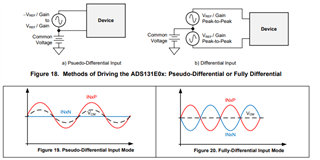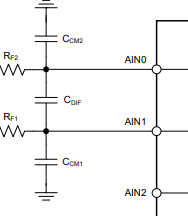We are using Ain0 and Ain1 to measure a pseudo-differential ±2.0V signal. We have ±2.5V for AVDD and AVSS and are using AVDD and AVSS as references. The current termination of the signal before the ADC inputs is a configuration of 10nF for Cdiff and 1nF for Ccm. We are not using the PGA and have set the register to bypass it.
The problem is that it appears that the internal ESD diodes are activating for signals larger than 60-70mV, driving the readings to 0V.
We have tried varying Cdiff and Ccm, adding inductors before Ain, adding resistors before Ain, and changing the common mode voltage from -2.5V to 0V.
We have had some measured progress with the above, measuring voltages up to 700mV before the diodes would activate. Unfortunately we have not yet been able to perform full-scale measurements.
Any assistance or reference documents on how to terminate a differential input would be greatly appreciated.





